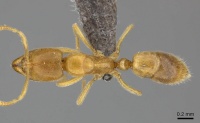Fisheropone
| Fisheropone | |
|---|---|

| |
| Fisheropone ambigua | |
| Scientific classification | |
| Kingdom: | Animalia |
| Phylum: | Arthropoda |
| Class: | Insecta |
| Order: | Hymenoptera |
| Family: | Formicidae |
| Subfamily: | Ponerinae |
| Tribe: | Ponerini |
| Alliance: | Odontomachus genus group |
| Genus: | Fisheropone Schmidt & Shattuck, 2014 |
| Type species | |
| Ponera ambigua, now Fisheropone ambigua | |
| Diversity | |
| 2 species (Species Checklist, Species by Country) | |
Known from two described and at least one undescribed species which are found in central and southern Africa. Nothing is known about the habits of Fisheropone. The lack of eyes, small body size and pale color suggest a hypogeic lifestyle, and this may explain their infrequent collection. However, this remains to be confirmed by field observations.
Identification
Schmidt and Shattuck (2014) - Fisheropone workers can be diagnosed by the following unique combination of characters: mandibles narrowly triangular, relatively long and without a basal pit or fovea; clypeus narrowly inserted between small frontal lobes, the antennal sockets closely approximated; propodeal spiracle slit-shaped; mesotibiae dorsally without abundant stout traction setae and ventral apex of the metatibia with a single pectinate spur; and petiole scale-like and thin. These ants bear a superficial resemblance to Hypoponera and Mesoponera in being relatively slender and with elongate mandibles and an impressed metanotal groove. They can be separated from Hypoponera by the slit-shaped rather than round propodeal spiracle, and from Mesoponera by the presence of only a single metatibial spur. Separation from the single African species of Cryptopone is based on the lack of a basal mandibular pit and mesotibial pusher setae, both of which are present in Cryptopone.
| See images of species within this genus |
Keys including this Genus
Distribution
Apparently restricted to Sub-Saharan Africa from Cameroon and Gabon to South Sudan.
Distribution and Richness based on AntMaps
Species by Region
Number of species within biogeographic regions, along with the total number of species for each region.
| Afrotropical Region | Australasian Region | Indo-Australian Region | Malagasy Region | Nearctic Region | Neotropical Region | Oriental Region | Palaearctic Region | |
|---|---|---|---|---|---|---|---|---|
| Species | 2 | 0 | 0 | 0 | 0 | 0 | 0 | 0 |
| Total Species | 2851 | 1736 | 3047 | 932 | 840 | 4391 | 1767 | 2925 |
Biology
Castes
Known only from the worker caste.
Phylogeny
| Ponerinae |
| ||||||||||||||||||||||||||||||||||||||||||||||||||||||||||||||||||||||||||||||||||||||||||||||||||||||||||||||||||||||||||||||||||||||||||||||||||||||||||||||||||||||||||||||||||||||||||||||||||||||||||||||||||||||||||||||||||||||||||||||||||||||||||||||||||||||||
See Phylogeny of Ponerinae for details.
Nomenclature
The following information is derived from Barry Bolton's Online Catalogue of the Ants of the World.
- FISHEROPONE [Ponerinae: Ponerini]
- Fisheropone Schmidt & Shattuck, 2014: 87. Type-species: Ponera ambigua, by original designation.
Unless otherwise noted the text for the remainder of this section is reported from the publication that includes the original description.
Taxonomic Notes
The only described species of Fisheropone was originally placed in Ponera as it has only a single metatibial spur. It is now known that this character occurs across the subfamily in unrelated genera and is of little phylogentic value. Recent preliminary molecular results provided by P. S. Ward (unpublished) place this genus within the Odontomachus genus group, and near species of Brachyponera and Euponera. While this placement appears well supported the taxon sampling in this preliminary work is limited and further details will be required to determine exact relationships.
Only a single species has been described from this genus although at least one undescribed species is known. The described species, Fisheropone ambigua, has been a junior secondary homonym of "Pachycondyla" ambigua André, 1890 and was replaced by "Pachycondyla" gulera Özdikmen, 2010. However, as these names are now placed in separate genera the replacement name is unnecessary and becomes a junior objective synonym of F. ambigua Weber.
Bolton & Fisher (2011) discuss F. ambigua and consider it closely related to weberi (Bernard, 1953). However, an examination of type material (held in Museum of Comparative Zoology) of weberi (Bernard) support the placement of this species in Mesoponera rather than Fisheropone, and thus these species are not treated as closely related in this study.
Description
Worker
Small (TL ca. 2 mm) slender ants with the standard characters of Ponerini. Mandibles narrowly triangular, relatively long. Eyes absent. Frontal lobes very small and closely approximated. Mesopleuron not divided by a transverse groove. Metanotal groove angular. Propodeum narrowed dorsally. Propodeal spiracles elongate. Metatibial spur formula (1p). Petiole squamiform. Gaster with a moderately weak girdling constriction between pre- and postsclerites of A4. Stridulitrum absent from pretergite of A4. Head and body finely punctate, with sparse pilosity but a dense fine pubescence. Color pale yellow.
Etymology
Fisheropone is named in honour of Brian Fisher, acknowledging his tremendous contributions to African and Malagasy myrmecology.
References
- Branstetter, M.G., Longino, J.T. 2022. UCE phylogenomics of New World Cryptopone (Hymenoptera: Formicidae) elucidates genus boundaries, species boundaries, and the vicariant history of a temperate–tropical disjunction. Insect Systematics & Diversity 6(1): 6:1-23 (doi:10.1093/isd/ixab031).
- Esteves, F.A., Fisher, B.L. 2021. Corrieopone nouragues gen. nov., sp. nov., a new Ponerinae from French Guiana (Hymenoptera, Formicidae). ZooKeys 1074, 83–173 (doi:10.3897/zookeys.1074.75551).
- Schmidt, C.A. & Shattuck, S.O. 2014. The higher classification of the ant subfamily Ponerinae (Hymenoptera: Formicidae), with a review of ponerine ecology and behavior. Zootaxa 3817, 1–242 (doi:10.11646/zootaxa.3817.1.1).

